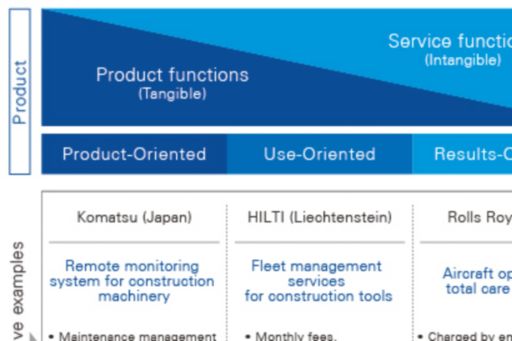Close-up 1: PSS x CVC accelerating the shift from selling products to selling services
PSS x CVC accelerating the shift from selling products
While the concept of shifting from selling products to selling services is becoming somewhat of a buzzword, many companies are still in the process of considering a move in this direction.
This trend is apparent across a range of industries, and construction is no exception. Using examples from around the world, I will explain the essence of this manufacturing industry-derived concept of breaking away from selling physical products. And the essence is this: companies must shift away from being businesses that manufacture goods toward ones that seek to enhance the way their goods are used. They can do this by clarifying both their service target and the value on offer - with help from external resources, especially digital technology.
Digital technology is making the product-as-a-service business model more feasible
To make the shift from selling products to selling services, the configuration of a Product-Service System (PSS) is said to be important. At the heart of the PSS concept is the desire to enable the cohesive delivery of both products and services by focusing on the value provided by the usage of a product. PSS itself originated from the manufacturing industry, where emphasis is placed on the utility derived from a product’s functions. The use of IoT and other digital technology is considered particularly effective for the successful implementation of PSS. The reason for this is that by installing various sensors into a product, IoT technology can be used to monitor how the product is actually being used.
PSS can be categorized into three types depending on whether the emphasis is on the product or the service, whether a product is actually provided or not, and whether ownership is transferred or not. Digital technology is a key driver for all three types. The first type is Product-Oriented PSS, which involves both product provision and transfer of ownership. A representative example of this type of PSS is Komatsu’s remote monitoring system for construction machinery. The company’s system is based around the use of sensors embedded in construction machinery. The second PSS type is the Use-Oriented PSS, in which products are provided but a transfer of ownership does not take place. Hilti, which provides fleet management services for construction tools, is a good example. Using sensors to monitor the status of their products, the company has been able to create a tool usage location tracking service as well as a service that recommends other tools based on the status of products currently in use. Finally, there is the Results-Oriented PSS, which places the strongest focus on service and provides neither products nor transfers ownership. An example of this is Rolls-Royce’s aircraft engine maintenance and total care service.The company tracks engine usage with real-time monitoring sensors embedded into the machine, and can carry out real-time diagnosis, route planning, and operational support to improve fuel consumption.
As the examples above demonstrate, the functional effectiveness of any type of PSS can be increased using IoT and other digital technologies.
Product-Service Systemtypes

Source:“Eight Types of Product Service System: Eight Ways to Sustainability? Experiences from SUSPRONET,”(TukkerArnold, 2004), KPMG analysis based on information available on each company’s website
Digitalization trends making headway in the construction industry
Recent years have seen digital technology being applied to a range of situations in the construction industry. The introduction of Building Information Modeling (BIM) has been particularly prevalent. BIM is a technology that allows users to build a virtual 3D model on a computer. But unlike conventional 3D CAD, in addition to providing a three-dimensional form, BIM presents a single model incorporating a variety of attribute information - from the specifications and performance of the components and equipment to be used in the building’s construction to the price and the construction period. This technology consolidates items that previously existed as separate models - such as all drawings and data lists - into a single interconnected model, so that when one drawing is modified, all other drawings and attribute information are updated automatically. Being able to carry out cross-sectional sharing and real-time information integration of BIM across each of the functions of the construction value chain (including planning, design and construction) results in a significant boost to operational efficiency.
Additionally, in recent years BIM is also being applied to post-construction facility management (FM). The benefits are again significant because the use of 3D makes it much easier to identify issues that cannot be measured using 2D diagrams, and because it is also possible to carry out energy cost simulations specific to a facility of property.
Vinci diversifying revenue sources in pursuit of user needs
As noted above, adoption of BIM through each of the functions of construction has yielded significant benefits at the construction stage, including improved efficiency and cost management. It should be said, however, that the building data being collected is static in the sense that it is from a specific point in time that has now passed - such as when construction was completed. To date the benefits of BIM have been limited to the player side of the equation, including design, construction and FM, but that may now be changing.
By installing sensors on buildings and facilities and incorporating the resulting data into BIM, the data can be considered to be “present continuous,” and tests are being carried out in the FM business to see if this approach benefits the user side of the equation.
This movement is being led by major French construction firm Vinci, group sales of which reached 5 trillion yen in fiscal 2018. In August 2018, the company announced that it is positioning a combination of BIM and IoT - the so-called “digital twin” - as an area of new growth in FM, applying it to buildings that it has constructed.
Through comprehensive collection and analysis of data generated through user interactions with buildings, Vinci aims to launch a new service in 2021 to better meet user needs. Although the specific details of the service have not been disclosed, Vinci is expected to focus on a combination of behavioral data, such as how users move and what they purchase, and environmental data, including the temperature, humidity and brightness within a facility.Analysis of this data could make it possible for Vinci to create a service that automatically fosters a facility environment that enhances the purchasing motivation of users. Also under consideration are the various possibilities with the development of a service that captures potential user needs and then proposes tenant business formats to owners in anticipation of demand.
What we can expect from the development of such services is an improvement in customer satisfaction and a subsequent increase in the sales performance of both the tenant and the owner. Vinci is in position to establish a competitive advantage in the FM field. From a medium- to long-term perspective, we are likely to see the implementation of a system whereby service fees are collected according to the results generated for tenants and owners.
Such initiatives by Vinci are consistent with the concept of Results-Oriented PSS, whereby user value is increased without a physical product or transfer of ownership. Vinci’s shift in focus - from how its buildings are built to how they are being used - is guiding the development of the company’s own unique PSS design.
I should point out that this initiative by Vinci is being driven by collaboration between its Open Laboratory Group and startups. Beyond its own R&D activity, the company has long been active in acquiring external capabilities, particularly those developed by startups. Since the mid-2010s, the company has held startup boot camps and contests in addition to setting up corporate venture capital (CVC) funds.In particular, the company has actively sought to introduce advanced technologies from outside the company, including IoT, AI and 3D printing. This includes partnerships with a startup developing wearable sensors that track human biological information and a startup developing a 3D printer that can process concrete.
The Open Laboratory Group was formed in 2017 in the midst of this movement. As mentioned at the beginning of this article, digital technology is the key to increasing the practicality of PSS. Vinci has achieved this mainly by incorporating the capabilities of startups.
From a business of making to a business of enhancing usage
Looking at the Japanese construction industry in terms of the shift from a “business of making” to a “business of enhancing usage,” a small number of general contractors have launched digital twin trials aimed at leveraging both IoT and BIM, but the feeling is that these initiatives have been limited to the streamlining of existing FM businesses by individual companies on their own.
With population decline expected to reduce demand for new construction in Japan in the years to come, a key issue of debate will be how to expand the scope of the shift from a “business of making” to a “business of usage enhancement.” Critical to its achievement will be incorporating the PSS concept of focusing on the usage value of the product or building while actively working to introduce not only internal technologies but also CVC and other mechanisms that seek to leverage on external technologies.That will mark the true transition to a product-as-a-service business model and will likely lead to a new era of improved customer value.
Author
Yuriko Nomura
Since joining KPMG in 2016, Yukiko Nomura has been engaged in corporate strategy formulation and M&A advisory services, mainly focusing on the manufacturing, automotive and logistics industries. Before joining the firm, she worked in scenario planning and marketing strategy development at a domestic consulting firm. She graduated from the University of Tokyo’s College of Arts and Sciences with a degree in Life and Cognitive Sciences, and also earned a Master of Business Administration (MBA) from Bond University in Australia.
© 2024 KPMG AZSA LLC, a limited liability audit corporation incorporated under the Japanese Certified Public Accountants Law and a member firm of the KPMG global organization of independent member firms affiliated with KPMG International Limited, a private English company limited by guarantee. All rights reserved. © 2024 KPMG Tax Corporation, a tax corporation incorporated under the Japanese CPTA Law and a member firm of the KPMG global organization of independent member firms affiliated with KPMG International Limited, a private English company limited by guarantee. All rights reserved.
For more detail about the structure of the KPMG global organization please visit https://kpmg.com/governance.

